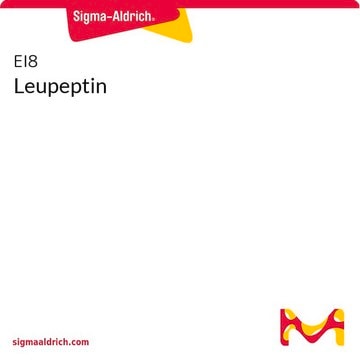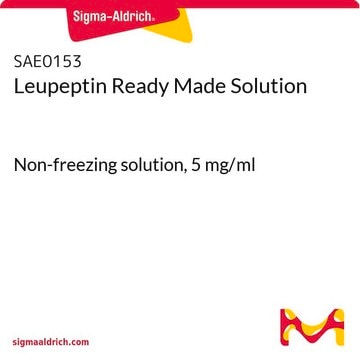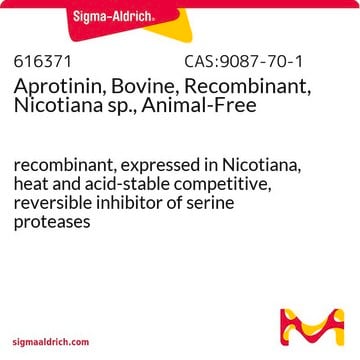108975
Leupeptin, Hemisulfate, Microbial
Leupeptin hemisulfate, CAS 103476-89-7, is a reversible inhibitor of trypsin-like proteases and cysteine proteases
동의어(들):
Leupeptin, Hemisulfate, Microbial, Ac-LLR-CHO, ½H₂SO₄
로그인조직 및 계약 가격 보기
모든 사진(1)
About This Item
실험식(Hill 표기법):
C20H38N6O4 · 0.5H2SO4
CAS Number:
Molecular Weight:
475.59
MDL number:
UNSPSC 코드:
12352202
NACRES:
NA.77
추천 제품
Quality Level
분석
≥90% (HPLC)
형태
lyophilized solid
제조업체/상표
Calbiochem®
저장 조건
OK to freeze
desiccated (hygroscopic)
색상
white
solubility
water: 50 mg/mL
배송 상태
ambient
저장 온도
−20°C
InChI
1S/C20H38N6O4/c1-12(2)9-16(24-14(5)28)19(30)26-17(10-13(3)4)18(29)25-15(11-27)7-6-8-23-20(21)22/h11-13,15-17H,6-10H2,1-5H3,(H,24,28)(H,25,29)(H,26,30)(H4,21,22,23)/p+1/t15-,16-,17-/m0/s1
InChI key
GDBQQVLCIARPGH-ULQDDVLXSA-O
일반 설명
A reversible inhibitor of trypsin-like proteases and cysteine proteases. Also known to inhibit activation-induced programmed cell death and to restore defective immune response in HIV+ donors. Often used for the inhibition of endoproteinase Lys-C, kallikrein, papain, plasmin, thrombin, cathepsin B, and trypsin. Leupeptin does not inhibit chymotrypsin, elastase, renin, or pepsin. The recommended working range is 10-100 µM for most applications.
A reversible inhibitor of trypsin-like proteases and cysteine proteases. Also known to inhibit activation-induced programmed cell death and to restore defective immune responses of HIV+ donors. Also available as a 50 mM solution in H2O (Cat. No. 509281).
생화학적/생리학적 작용
Cell permeable: no
Primary Target
trypsin- and cysteine-like proteases
trypsin- and cysteine-like proteases
Product does not compete with ATP.
Reversible: yes
경고
Toxicity: Standard Handling (A)
서열
Ac-Leu-Leu-arginal, hemisulfate
재구성
Following reconstitution, aliquot and freeze (-20°C) for long term storage or refrigerate (4°C) for short term storage. Aqueous stock solutions are stable for up to 1 week at 4°C or for up to 1 month at -20°C.
기타 정보
Montenez, J.P., et al. 1994. Toxicol. Lett. 73, 201.
Sarin, A., et al. 1994. J. Immunol.153, 862.
Sarin, A., et al. 1994. J. Immunol.153, 862.
법적 정보
CALBIOCHEM is a registered trademark of Merck KGaA, Darmstadt, Germany
Storage Class Code
11 - Combustible Solids
WGK
WGK 3
Flash Point (°F)
Not applicable
Flash Point (°C)
Not applicable
시험 성적서(COA)
제품의 로트/배치 번호를 입력하여 시험 성적서(COA)을 검색하십시오. 로트 및 배치 번호는 제품 라벨에 있는 ‘로트’ 또는 ‘배치’라는 용어 뒤에서 찾을 수 있습니다.
이미 열람한 고객
Fang Wu et al.
Nature communications, 14(1), 6208-6208 (2023-10-06)
Lysine acetylation has been discovered in thousands of non-histone human proteins, including most metabolic enzymes. Deciphering the functions of acetylation is key to understanding how metabolic cues mediate metabolic enzyme regulation and cellular signaling. Glucose-6-phosphate dehydrogenase (G6PD), the rate-limiting enzyme
John M Barbaro et al.
Journal of leukocyte biology, 112(5), 1317-1328 (2022-10-08)
HIV-associated neurocognitive impairment (HIV-NCI) is a debilitating comorbidity that reduces quality of life in 15-40% of people with HIV (PWH) taking antiretroviral therapy (ART). Opioid use has been shown to increase neurocognitive deficits in PWH. Monocyte-derived macrophages (MDMs) harbor HIV
Joel Vega-Badillo et al.
STAR protocols, 4(2), 102336-102336 (2023-06-04)
Binding affinity quantitatively describes the strength of a molecular interaction and is reported by the equilibrium dissociation constant (KD). Here, we present a protocol to measure KD of mammalian microRNA-loaded Argonaute2 protein by double filter binding. We describe steps for
Lisa Marquardt et al.
Autophagy, 19(1), 278-295 (2022-05-17)
The yeast PROPPIN Atg18 folds as a β-propeller with two binding sites for phosphatidylinositol-3-phosphate (PtdIns3P) and PtdIns(3,5)P2 at its circumference. Membrane insertion of an amphipathic loop of Atg18 leads to membrane tubulation and fission. Atg18 has known functions at the
Mohammad Haeri et al.
Methods in molecular biology (Clifton, N.J.), 884, 17-39 (2012-06-13)
Transgenesis, the process of incorporating an exogenous gene (transgene) into an organism's genome, is a widely used tool to develop models of human diseases and to study the function and/or regulation of genes. Generating transgenic Xenopus is rapid and involves
자사의 과학자팀은 생명 과학, 재료 과학, 화학 합성, 크로마토그래피, 분석 및 기타 많은 영역을 포함한 모든 과학 분야에 경험이 있습니다..
고객지원팀으로 연락바랍니다.











